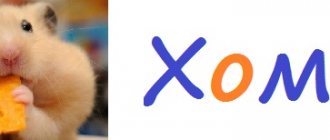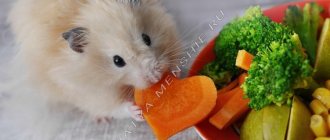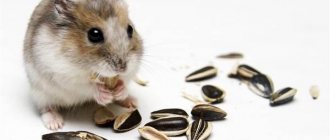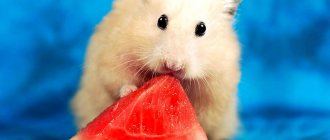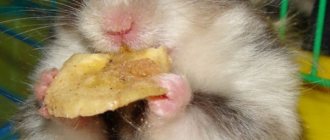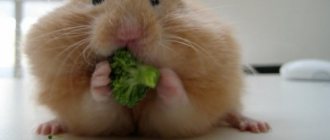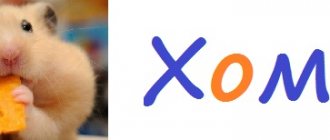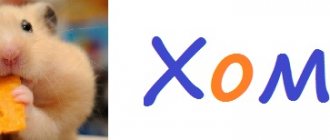When getting a hamster as a pet, you should pay close attention to its diet. You should find out which foods are suitable for a rodent, and which ones are not recommended to be added to the diet. This will help keep the animal healthy and cheerful. Let's figure out whether hamsters can have milk and dairy products. Please note that feeding recommendations may vary depending on the breed of your pet.
What are the benefits of milk
What do we even know about him? White, tasty, healthy. If you drink a lot of cold things, your throat will hurt. In addition, this natural product contains:
- calcium;
- magnesium;
- phosphorus;
- other elements for the correct and harmonious development of a young body.
There is no doubt about the benefits of this product for humans, but does this apply to hamsters? Before answering this question, I would like to cite one interesting fact :
Among all mammals, only humans, as adults, are able to drink milk without harm to their health thanks to a mutation that occurred several thousand years ago.
I very much suspect that now all cat owners will snort indignantly and will be partly right, but only partly. Cats, no matter how strange it may sound, should not be fed natural milk all the time either. Well, they don’t produce lactose to digest milk sugar. If you don’t believe me, read the information on specialized cat websites.
Completely prohibited
Do not give dzungaria under any circumstances. If you break the ban, it will lead to the death of your pet.
Prohibited products:
- pasta and other flour products;
- legumes;
- almond;
- Brazilian nut;
- Pine nuts;
- apricot and cherry pits;
- chestnuts;
- acorns;
- melon;
- watermelon;
- potato;
- onion;
- cabbage;
- garlic;
- citruses;
- Exotic fruits;
- persimmon;
- elder;
- honeysuckle;
- branches of coniferous trees;
- sorrel;
- raw meat;
- sausage, frankfurters;
- cheese;
- milk;
- mushrooms.
So should you give your hamster milk or not?
The question is ambiguous. This is not contraindicated for most breeds, but at the same time, it is not recommended for anyone. Exception: rare cases when the pet’s body needs certain nutrients.
In any case, this product can be introduced into a rodent’s diet only as prescribed by a veterinarian in the following cases:
- During certain illnesses, when the animal’s body is severely weakened.
- To maintain the health of a pregnant or lactating female, as well as for babies who do not have access to breast milk.
Separately, it is worth mentioning the two most popular breeds - Syrians and Djungarians. So, Dzungarians are known for their weak immunity. Even a teaspoon of milk will easily knock them down; it is completely contraindicated for them. If you don’t want to turn your pet’s life into sheer malaise and nausea, refrain from treating him to any fermented milk products. Syrians are distinguished by stronger immunity, capable of withstanding most of the problems that would have killed the Djungarian long ago, but milk is also not recommended for them, like all rodents in general.
Ready-made dry food
Brands of food for Djungarian hamsters are distinguished by their diversity. We will look at the most popular ones separately, then we will give some useful tips on choosing the appropriate option.
Description of popular brands
The most popular brands of food for rodents of this breed among breeders are as follows.
This:
- Versele-Laga "Prestige Mini Hamster Nature" is one of the best foods made specifically for this breed of rodents. The diet of the Djungarian hamster must be balanced and the manufacturer has taken this nuance into account. The composition contains fruits, vegetables, proteins, nuts and yeast. If your hamster is overweight, you should choose pineapple with raisins from the food.
- Chika-Bio “Food for Djungarian hamsters” is a domestic analogue, which, contrary to stereotypes, is not inferior in quality to the original. The ratio of ingredients and the size of the pieces are selected specifically for hamsters of this breed. This brand stands out for its reasonable price and good quality.
- JR Farm Hamster is a universal food for hamsters. It stands out for its high taste qualities. Hamsters eat all the food without selecting the most delicious parts. It is also worth mentioning the composition of this product, which contains various sources of protein, the prebiotic inulin, which improves digestion, and yucca extract, which reduces odor.
- Vitapol and Lolo pets. This brand should be stored in a separate glass container with a tight lid, and not in a bag. The mixtures are distinguished by the vastness of their diet, which will have to be diversified only in case of pregnancy, lactation, growth period, or mating time. The animal can live for a long time eating only this food.
- Padovan Grandmix Criceti. Complete food. Vacuum packaging makes it possible to preserve all properties. For a fairly low price, the buyer receives good quality rodent food. The disadvantages include a lack of protein.
How to choose the right one
A hamster is not an exotic animal and there should be no problems finding food. But in any case, you should read the composition before purchasing. Look for a food with the most balanced ratio of ingredients so as not to compensate for the lack of protein with tasty but harmful additives.
As mentioned earlier, food should be the basis of the dzhungarik’s diet. However, additional food outside of the mixture will only benefit. That's why we provide detailed information about what hamsters can and cannot do in the form of a list.
Is it possible to give a hamster kefir?
What is useful for a person is not always useful for his pet. Remember this rule. You will encounter it very often. Kefir, in any quantity, is harmful to the hamster. Consumption of kefir always leads to disruption of the gastrointestinal tract in rodents. At best, they face:
- diarrhea;
- constipation;
- weakened immunity;
- general lethargy.
To avoid all this, it is important to remember one rule - no kefir for rodents in any doses.
Other dairy products
All other dairy products should not be given to your hamster.
Butter and cream have a high fat content, so their consumption has a detrimental effect on the liver and digestive tract.
Milk cereals are also harmful to your hamster. The combination of thoroughly cooked cereals and large amounts of milk disrupts the functioning of the gastrointestinal tract.
The list of prohibited products also includes ice cream. It is dangerous for animals even in small quantities, since their bodies are not capable of absorbing glucose. Accordingly, after eating ice cream, a hamster can become seriously ill.
As a result of improper feeding, the hamster becomes inactive and lethargic. Harmful substances contained in foods are not only poorly digested, but also overload blood vessels.
Is it possible to feed cottage cheese, sour cream or yogurt?
Gradually, the article pushes us to the conclusion that fermented milk products are not recommended for inclusion in the diet of domestic rodents in any form. The only exception is low-fat cottage cheese without sugar - and even then, with strict restrictions and as prescribed by a veterinarian. Also, hamsters cannot have sour cream because of its fat content - it never contains less than 10% fat. Yogurts, even low-fat ones, should not be given either. They are also full of sugar, especially in store-bought yoghurts, which have various flavorings.
For owners of Syrians and Dzungarians
Regardless of the breed, hamsters have the same diet. Both Syrians and Dzungarians can be offered low-fat cottage cheese and cheese a couple of times a month.
Milk contains proteins - casein and albumin, which are dangerous to the health of little jungarians. For larger Syrians, it can be given in small portions, separately from other foods.
If you want to treat a sick pet with dairy cuisine, consult a specialist. Such products, if used incorrectly, can worsen the animal’s illness.
Proper pet care
When planning to purchase individuals of the hamster family, you should first think about whether following the rules of care, which include such points as:
- washing the cage, feeder, drinking bowl without disturbing the usual arrangement of objects in the pet’s home on a weekly basis;
- changing bedding, cleaning bins of spoiled food weekly;
- daily toilet care;
- creating comfortable, stable conditions without disturbing them.
It is extremely important not to disturb the animal’s way of life, determined by it after moving into the cage. Otherwise, the animal receives too much nervous stress, experiences stress and dies a sudden death. It is not recommended to move the rodent’s home from place to place, or to let it out of its designated living space. To satisfy your baby's physical activity, it is enough to install a running wheel.
Cheese
It is also not recommended to feed your hamster cheese, since the hard varieties are made with salt and spices, while the soft ones have a viscous consistency and can stick in the pet’s cheek pouches, which in turn can lead to serious consequences. Read more about whether hamsters can eat cheese here.
For your pet to live a long and happy life, you need to feed it properly. Therefore, you should not feed your rodent everything, including dairy products. We hope that you now know whether hamsters can have milk, cottage cheese, yogurt, kefir and cheese, as well as when and how often you can feed your pet dairy products.
Did you like the article? Share with friends: [supsystic-social-sharing id=”1"]
- Related Posts
- What cereals can hamsters eat?
- Can hamsters eat beets?
- Can hamsters eat zucchini?
« Previous entry
Interesting Facts
Djungarian hamsters were domesticated only in the middle of the twentieth century. Rodents of this breed feel comfortable in an apartment and get along well with people.
A few facts will help you better understand these animals:
- Rodents' teeth grow throughout their lives, so they need mineral stones to grind them down. Too large incisors can damage the animal's delicate cheeks.
- Rodents of this breed do not hibernate in winter, but in severe frosts they become numb for several hours. This condition may mean that the animal is stressed or lacking oxygen.
- At temperatures below +16°C, hamsters shed. In winter, their gray color becomes lighter.
- They are capable of traveling several tens of kilometers during the night. In the wild, hamsters divide territory and, if invaded, fiercely defend their home, so it is not worth putting 2 animals in a cage. They do well alone.
- Pregnancy in these rodents lasts for 25 days. From 1 to 11 cubs are born.
- The Djungarian hamster is a dwarf breed, individuals reach 10 cm in length and weigh from 30 to 65 g. The animals are distinguished by smooth fur and a dark stripe along the body, which most individuals have.
- Rodents of this breed quickly get used to humans, but taming should be gradual.
Feeding the Cubs
In some cases, the litter has to be fed by the owner. A few simple rules increase your chances of success:
- choose diluted cow's milk or infant formula;
- choose pasteurized, boiled milk;
- a syringe without a needle or a pipette will help in the process;
- milk is poured in dropwise portions until saturated;
Milk is a product of questionable usefulness. If you want to pamper your pet, it is better to offer him fresh fruits or vegetables, a piece of boiled lean meat.
The health of the pet is much more important than dubious variety.

